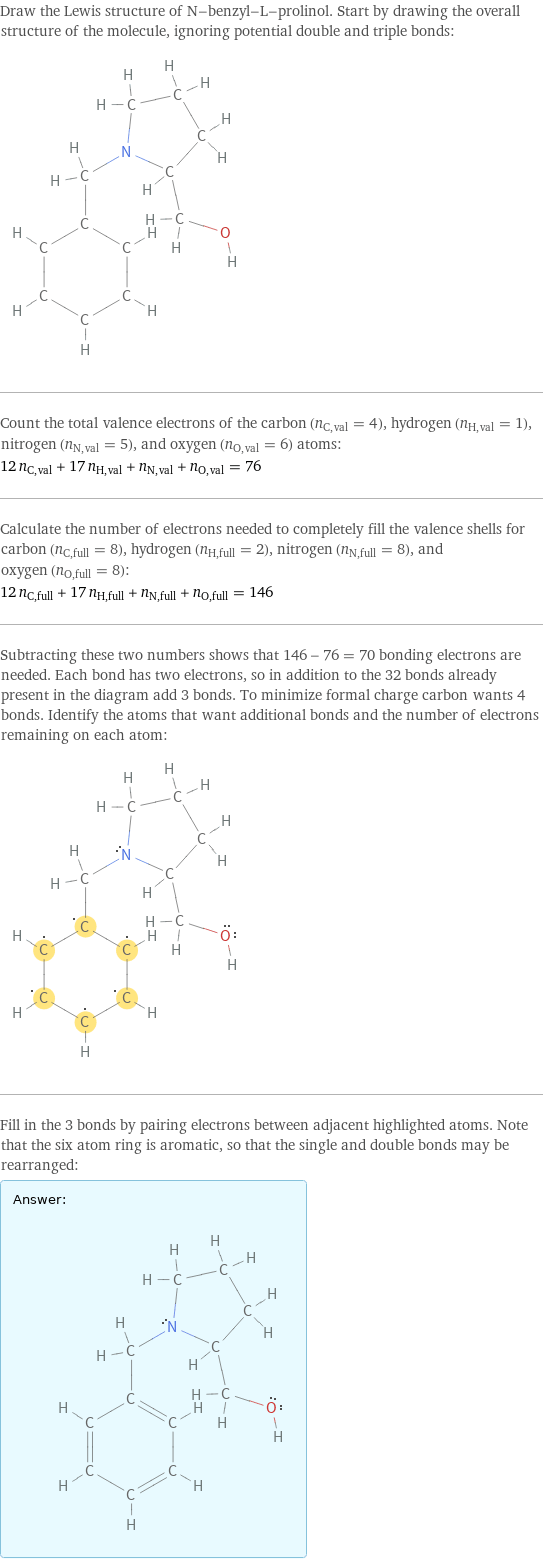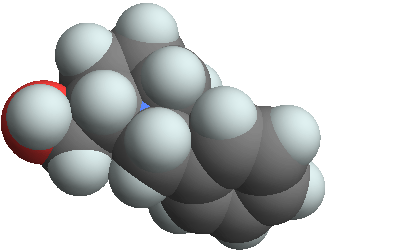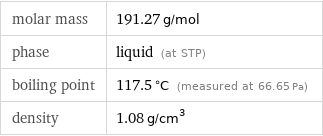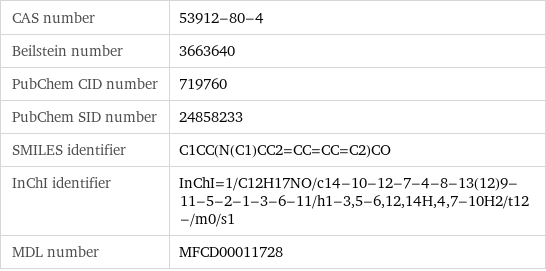Input interpretation

N-benzyl-L-prolinol
Chemical names and formulas
![formula | C_12H_17NO name | N-benzyl-L-prolinol IUPAC name | [(2S)-1-(phenylmethyl)-2-pyrrolidinyl]methanol alternate names | [(2S)-1-(benzyl)pyrrolidin-2-yl]methanol | [(2S)-1-(phenylmethyl)pyrrolidin-2-yl]methanol | (S)-(-)-1-benzylpyrrolidine-2-methanol mass fractions | C (carbon) 75.4% | H (hydrogen) 8.96% | N (nitrogen) 7.32% | O (oxygen) 8.36%](../image_source/dd8d37cc1956e93cf0f63f550d792908.png)
formula | C_12H_17NO name | N-benzyl-L-prolinol IUPAC name | [(2S)-1-(phenylmethyl)-2-pyrrolidinyl]methanol alternate names | [(2S)-1-(benzyl)pyrrolidin-2-yl]methanol | [(2S)-1-(phenylmethyl)pyrrolidin-2-yl]methanol | (S)-(-)-1-benzylpyrrolidine-2-methanol mass fractions | C (carbon) 75.4% | H (hydrogen) 8.96% | N (nitrogen) 7.32% | O (oxygen) 8.36%
Lewis structure

Draw the Lewis structure of N-benzyl-L-prolinol. Start by drawing the overall structure of the molecule, ignoring potential double and triple bonds: Count the total valence electrons of the carbon (n_C, val = 4), hydrogen (n_H, val = 1), nitrogen (n_N, val = 5), and oxygen (n_O, val = 6) atoms: 12 n_C, val + 17 n_H, val + n_N, val + n_O, val = 76 Calculate the number of electrons needed to completely fill the valence shells for carbon (n_C, full = 8), hydrogen (n_H, full = 2), nitrogen (n_N, full = 8), and oxygen (n_O, full = 8): 12 n_C, full + 17 n_H, full + n_N, full + n_O, full = 146 Subtracting these two numbers shows that 146 - 76 = 70 bonding electrons are needed. Each bond has two electrons, so in addition to the 32 bonds already present in the diagram add 3 bonds. To minimize formal charge carbon wants 4 bonds. Identify the atoms that want additional bonds and the number of electrons remaining on each atom: Fill in the 3 bonds by pairing electrons between adjacent highlighted atoms. Note that the six atom ring is aromatic, so that the single and double bonds may be rearranged: Answer: | |
3D structure

3D structure
Basic properties

molar mass | 191.27 g/mol phase | liquid (at STP) boiling point | 117.5 °C (measured at 66.65 Pa) density | 1.08 g/cm^3
Units

Liquid properties (at STP)

density | 1.08 g/cm^3 refractive index | 1.541
Units

Chemical identifiers

CAS number | 53912-80-4 Beilstein number | 3663640 PubChem CID number | 719760 PubChem SID number | 24858233 SMILES identifier | C1CC(N(C1)CC2=CC=CC=C2)CO InChI identifier | InChI=1/C12H17NO/c14-10-12-7-4-8-13(12)9-11-5-2-1-3-6-11/h1-3, 5-6, 12, 14H, 4, 7-10H2/t12-/m0/s1 MDL number | MFCD00011728
Safety properties

flash point | 110 °C